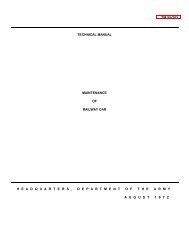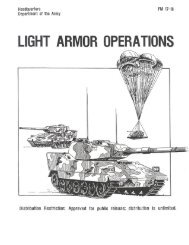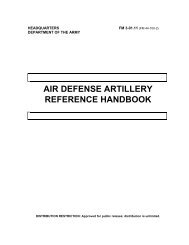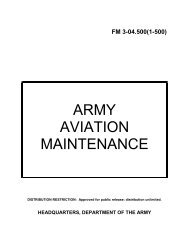fm 44-100 us army air and missile defense operations
fm 44-100 us army air and missile defense operations
fm 44-100 us army air and missile defense operations
You also want an ePaper? Increase the reach of your titles
YUMPU automatically turns print PDFs into web optimized ePapers that Google loves.
FM <strong>44</strong>-<strong>100</strong><br />
systems require lift to the area of <strong>operations</strong> to provide early <strong>air</strong> <strong>and</strong> <strong>missile</strong><br />
<strong>defense</strong> protection of the POD, LOC, <strong>and</strong> lodgment area. ADA systems m<strong>us</strong>t<br />
deploy rapidly <strong>and</strong> in sufficient numbers to defeat the threat. During the entry<br />
stage, ADA counters enemy RSTA, <strong>air</strong>, <strong>and</strong> <strong>missile</strong> attack <strong>operations</strong>.<br />
Long-range DCA is normally the responsibility of Navy, Marine Corps, or Air<br />
Force <strong>air</strong> assets, but ADA provides the only protection against TMs, UAVs,<br />
<strong>and</strong> helicopters. This multiservice <strong>air</strong> <strong>and</strong> <strong>missile</strong> <strong>defense</strong> requires integration<br />
of the ADA concept of <strong>operations</strong> into the joint counter<strong>air</strong> <strong>and</strong> TMD<br />
plans.<br />
6-91. ADA m<strong>us</strong>t accompany the force, particularly in regions where large distances<br />
are traversed in a short period of time, during expansion of the lodgment.<br />
ADA systems m<strong>us</strong>t be highly mobile to provide the force the low- <strong>and</strong><br />
medium-altitude protection required during rapid movement. Counter-RSTA<br />
remains an imperative. Employment of additional ADA strengthens the <strong>air</strong><br />
<strong>and</strong> <strong>missile</strong> <strong>defense</strong>s at the lodgment area <strong>and</strong> the logistics base.<br />
6-92. ADA shifts emphasis from counter-RSTA to force protection during the<br />
<strong>operations</strong> stage. The operation either terminates successfully or escalates<br />
into <strong>operations</strong> similar to those of an established theater. If escalation occurs,<br />
additional ADA m<strong>us</strong>t deploy <strong>and</strong> integrate with the ADA resources previo<strong>us</strong>ly<br />
deployed to s<strong>us</strong>tain <strong>air</strong> <strong>and</strong> <strong>missile</strong> <strong>defense</strong> <strong>operations</strong>.<br />
6-93. Whether supporting close, deep, or rear <strong>operations</strong>, the ADA comm<strong>and</strong>er<br />
at all levels develops <strong>and</strong> refines the ADA concept of <strong>operations</strong> to<br />
achieve the objectives of all tactical-level <strong>air</strong> <strong>and</strong> <strong>missile</strong> <strong>defense</strong> planning.<br />
The ADA comm<strong>and</strong>er's objective is to provide the force with s<strong>us</strong>tained, low- to<br />
high-altitude <strong>air</strong> <strong>and</strong> <strong>missile</strong> <strong>defense</strong> of priority forces <strong>and</strong> assets throughout<br />
the battlefield. When developing the concept of <strong>operations</strong>, the ADA comm<strong>and</strong>er<br />
considers the specific characteristics of the operation <strong>and</strong> the approved<br />
<strong>air</strong> <strong>and</strong> <strong>missile</strong> <strong>defense</strong> priorities. The comm<strong>and</strong>er also assesses the<br />
potential contributions of joint counter<strong>air</strong>, TMD, <strong>and</strong> non-ADA Army resources.<br />
After considering the individual <strong>and</strong> combined capabilities of all<br />
available ADA resources, the ADA comm<strong>and</strong>er effects the necessary coordination<br />
to integrate <strong>and</strong> synchronize their contributions with the supported<br />
force's concept of <strong>operations</strong>.<br />
6-94. The ADA concept of <strong>operations</strong> in close <strong>operations</strong> foc<strong>us</strong>es on the protection<br />
of the maneuver force <strong>and</strong> reserves. ADA protection is weighted toward<br />
the main effort. In close <strong>operations</strong>, ADA <strong>and</strong> other members of the combined<br />
arms team foc<strong>us</strong> their <strong>air</strong> <strong>defense</strong> efforts on defeating enemy attack helicopters<br />
<strong>and</strong> UAVs while retaining the tactical flexibility to destroy attacking<br />
fixed-wing <strong>air</strong>craft. The combination of ADA <strong>and</strong> combined arms fires significantly<br />
increases friendly force effectiveness. A result of this synergistic effect<br />
is that the force kills more enemy <strong>air</strong>, loses fewer systems, <strong>and</strong> gains greater<br />
freedom to maneuver.<br />
6-95. ADA m<strong>us</strong>t maneuver with the force to provide low-altitude protective<br />
fires in deep <strong>operations</strong>. Overwatch ADA fires may come from supporting<br />
longer-range ADA resources. As in close <strong>operations</strong>, maneuver elements may<br />
also engage <strong>air</strong> threats with their organic weapons systems. The ADA comm<strong>and</strong>er<br />
m<strong>us</strong>t integrate supporting Air Force <strong>and</strong> Army aviation fires whenever<br />
possible. Air <strong>and</strong> <strong>missile</strong> <strong>defense</strong> assets may consist of only SHORAD<br />
6-21











